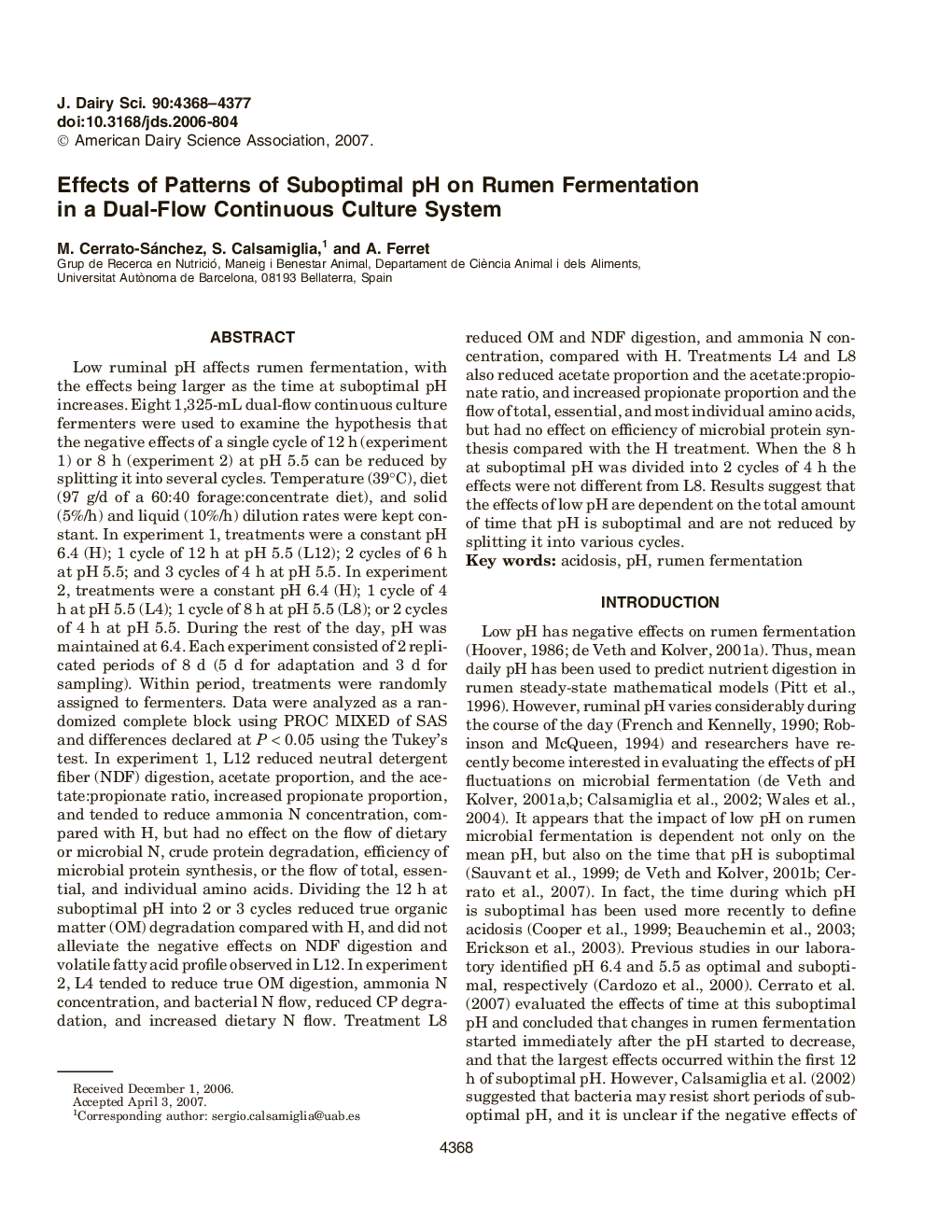| Article ID | Journal | Published Year | Pages | File Type |
|---|---|---|---|---|
| 2440640 | Journal of Dairy Science | 2007 | 10 Pages |
Abstract
Low ruminal pH affects rumen fermentation, with the effects being larger as the time at suboptimal pH increases. Eight 1,325-mL dual-flow continuous culture fermenters were used to examine the hypothesis that the negative effects of a single cycle of 12 h (experiment 1) or 8 h (experiment 2) at pH 5.5 can be reduced by splitting it into several cycles. Temperature (39°C), diet (97 g/d of a 60:40 forage:concentrate diet), and solid (5%/h) and liquid (10%/h) dilution rates were kept constant. In experiment 1, treatments were a constant pH 6.4 (H); 1 cycle of 12 h at pH 5.5 (L12); 2 cycles of 6 h at pH 5.5; and 3 cycles of 4 h at pH 5.5. In experiment 2, treatments were a constant pH 6.4 (H); 1 cycle of 4 h at pH 5.5 (L4); 1 cycle of 8 h at pH 5.5 (L8); or 2 cycles of 4 h at pH 5.5. During the rest of the day, pH was maintained at 6.4. Each experiment consisted of 2 replicated periods of 8 d (5 d for adaptation and 3 d for sampling). Within period, treatments were randomly assigned to fermenters. Data were analyzed as a randomized complete block using PROC MIXED of SAS and differences declared at P < 0.05 using the Tukey's test. In experiment 1, L12 reduced neutral detergent fiber (NDF) digestion, acetate proportion, and the acetate:propionate ratio, increased propionate proportion, and tended to reduce ammonia N concentration, compared with H, but had no effect on the flow of dietary or microbial N, crude protein degradation, efficiency of microbial protein synthesis, or the flow of total, essential, and individual amino acids. Dividing the 12 h at suboptimal pH into 2 or 3 cycles reduced true organic matter (OM) degradation compared with H, and did not alleviate the negative effects on NDF digestion and volatile fatty acid profile observed in L12. In experiment 2, L4 tended to reduce true OM digestion, ammonia N concentration, and bacterial N flow, reduced CP degradation, and increased dietary N flow. Treatment L8 reduced OM and NDF digestion, and ammonia N concentration, compared with H. Treatments L4 and L8 also reduced acetate proportion and the acetate:propionate ratio, and increased propionate proportion and the flow of total, essential, and most individual amino acids, but had no effect on efficiency of microbial protein synthesis compared with the H treatment. When the 8 h at suboptimal pH was divided into 2 cycles of 4 h the effects were not different from L8. Results suggest that the effects of low pH are dependent on the total amount of time that pH is suboptimal and are not reduced by splitting it into various cycles.
Keywords
Related Topics
Life Sciences
Agricultural and Biological Sciences
Animal Science and Zoology
Authors
M. Cerrato-Sánchez, S. Calsamiglia, A. Ferret,
